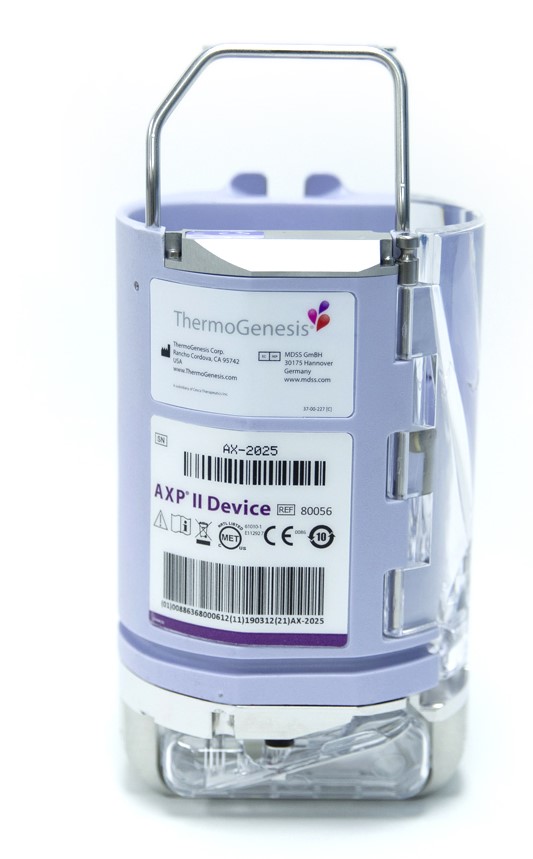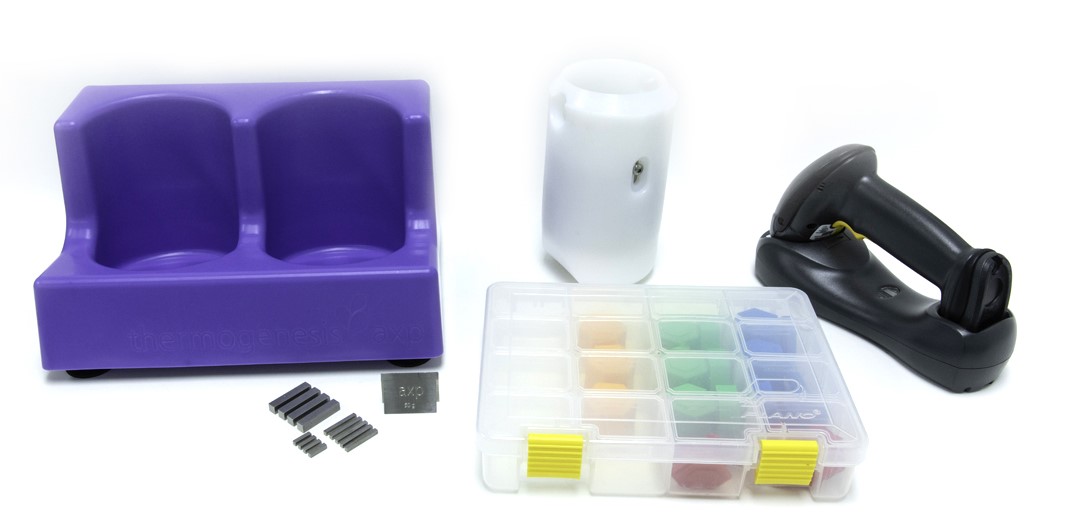AXP® II System
The AXP® II System allows the fast, automated, and reproducible separation of cord blood in a closed and sterile environment.
Overview
Raising the Standard on Cord Blood Processing
The AXP® II System has been designed to provide high-quality stem cell concentration from cord blood. So when you are processing cord blood samples, using the AXP® II System, you can be confident that you are isolating and saving the highest concentration of stem cell rich buffy coat while retaining their viability.
Automation at its Finest
Cord blood is transferred into the processing bag set which is placed in the AXP Device and then centrifuged. The AXP Device fits into most standard blood bank centrifuge buckets allowing up to six samples to be processed simultaneously. During centrifugation, component stratification and separation occurs. Red blood cells (RBC) are transferred to a separate sterile bag, the buffy coat which contains the mononuclear cell (MNC) rich layer is delivered to a separate sterile freezing bag while the plasma remains in the processing bag. The AXP II System does not require the addition of hetastarch for successful capturing of MNCs.
Complete System Solution
Highest Yields. Viable Cells.
- Precise delivery of final volume target1
- Reliable collection of all fractions: buffy coat, RBC, and plasma
- Viable CD34+ stem cell recovery of >97% is higher than other available systems2
- Cord blood units (CBU) processed with AXP are richer in mononuclear cells (MNC) than units conventionally processed having similar total nucleated cells (TNC)1
- Hematocrit is consistently <30% in final storage volume1
Uncompromising Safety. Quality Results.
- Utilizes a functionally closed processing set
- Separate collection bags for capturing buffy coat, plasma, and red blood cells
- Integrated sampling pillows for pre- and post-processing sterile sample collection
- Transferring cord blood from collection bag can be done by:
- Sterile weld
- Spike port
- In-line clot filter and multiple sampling ports
- Integrated DMSO inlet filter and tubing
Efficient Automation. Integrated Quality Control.
- XpressTRAK® software tracks and documents data specific to each cord blood unit processed
- Captures sample processing data to assist with quality assurance and compliance with current good tissue practices (cGTP) and good manufacturing practices (cGMP)
- Stores processing data in a searchable, sortable database
- Customizable data fields and reports
INDICATION
The AXP® II System is a cord blood processing system intended for laboratory use in combination with a specific and compatible single-use separation kit supplied by ThermoGenesis. The AXP II System allows the fast, automated, and reproducible separation of cord blood in a closed and sterile environment.
1. Data on file.
2. Rubenstein P. Cord blood banking for clinical transplantation. Bone Marrow Transplantation 2009; 44:635-642.
Working with the AXP® II System
Cell Separation
AXP® System is a fully automated, programmable cell separation and recovery system, utilizing microprocessors and flow controlled optical sensors. The AXP System requires no manual processing and is designed to reduce human error and deliver consistent, reproducible results.
AXP directs cord blood components (buffy coat, plasma, red blood cells) into separate sterile bags. The buffy coat volume is defined by the user and is captured in a freezing bag which is ideal for cryopreservation and use in transplantation. Accurate and reproducible spin speeds, acceleration and G forces ensures accurate processing without damage to the cells.
Process
Cord blood is transferred into the processing bag set which is placed in the AXP device and then centrifuged. The AXP device fits into most standard blood bank centrifuge buckets allowing up to six samples to be processed simultaneously. During centrifugation, component stratification and separation occurs. Red blood cells (RBC) are transferred to a separate sterile bag, the buffy coat which contains the mononuclear cell (MNC) rich layer is delivered to a separate sterile freezing bag while the plasma remains in the processing bag. The AXP System does not require the addition of hetastarch for successful capturing of MNCs.


- Transfer the cord blood to the AXP Processing Bag Set and collect a pre-processing sample using the sampling pillow.
- Load the processing set into the AXP Device.
- Spin up to six AXP devices in the centrifuge to separate and harvest the stem-cell rich blood fraction.
- Remove the Processing Bag Set.
- Place the AXP Device into the Docking Station.
- Processing data is automatically downloaded and captured in the XpressTRAK® Software.
- Collect a post-processing sample using the sampling pillow, add cryoprotectant to the buffy coat, seal the freezing bag and place sample in an overwrap bag and canister for storage in the BioArchive® system.
Recovery Rates
The following table represents the typical recovery rates users can expect from the AXP System.
| Cell Population | Pre-Process (Cord Blood) | Post-Process (Harvest MNC Fraction) | % Recovery |
| Total Nucleated Cells x 106 | 1150 ± 273.4 | 969 ± 225.3 | 84.8 ± 9.2 |
| Total Mononuclear Cells x 106 | 453 ± 134.6 | 442 ± 126.6 | 97.9 ± 4.9 |
| Total CD34+ Cells x 103 (%Viable) | 3364 ± 1594.0 (99.7 ± .03) | 3256 ± 1412.7 (99.8 ± .02) | 98.2 ± 8.0 |
| CFU x 106 | 2.6 ± 1.1 | 2.5 ± 1.0 | 94.6 ± 7.0 |
White Papers, Abstracts & Presentations
Brochures
Posters
-
-
- Rosenthal J, Brown H.L, and Harris D.T. Cell Recovery Following Implementation of an Automated Cord Blood Processing System in a High Volume Laboratory. American Society for Blood and Marrow Transplantation Meeting (2008 ASBMT).
- Li J, Nguyen M, Gerhard B, Walker J, Wirthlin L, Gruenloh W, Nolta J, Lagarias D, Weatherford C, Marr D, and Chapman J. Automated Volume Reduction of Human Cord Blood Using the AXP AutoXpress™ Platform: A Study with HES. International Society for Stem Cell Research (2007 ISSCR), Cairns, Australia.
- Li J, Zhu H, Nguyen M, Emmanuel P, Baker B, Marr B, Weatherford C, and Chapman J. Validation Study of Mononuclear Cell Recovery Using the AXP AutoXpress™ Platform. European Society for Blood and Marrow Transplantation Meeting (2007 EBMT), Lyon, France.
- Dorila L, Chapman J, Marr D, Kumar V, Coehlo P, and Rubinstein P. ThermoGenesis AXP AutoXpress Platform and BioArchive System for Automated Cord Blood Banking. International Society of Blood Transfusion (2006 ISBT), Cape Town, South Africa.
- Chapman J, Marr D, Baker B, and Kryston K. Automated Separation of Cord Blood MNC Fraction in a Closed System: ThermoGenesis AXP™ System. International Symposium on Stem Cells: Premises and Promises for Research and Therapeutics (2005 ISSC), Mumbai, India.
-
Published Literature
-
-
- Badowski MS, Harris DT. Collection, processing, and banking of umbilical cord blood stem cells for transplantation and regenerative medicine. Methods Mol Biol. 2012;879:279-290.
- Roh EY, et al. Cord blood volume reduction using the automated devices Sepax® S-100 and AXP™ AutoXpress platform. Korean J Blood Transfus. 2007;18 (3):219-226.
- Rubinstein, P. Cord blood banking for clinical transplantation. Bone Marrow Transplantation. 2009;44(10):635-42.
- Solves P, Mirabet V, Blanquer A , et al. A new automatic device for routine cord blood banking: Critical analysis of different volume reduction methodologies. Cytotherapy. 2009;11(8):1101-1107.
- Solves P, Planelles D, Mirabet V, et al. Qualitative and quantitative cell recovery in umbilical cord blood processed by two automated devices in routine cord blood banking: A comparative study. Blood Transfus. 2013;11(3):405-411.
- Takanashi M, Oba A, Ogawa A, et al. Red blood cell depletion of cord blood using an automated system- Evaluation of the AXP system. Japanese Journal of Transfusion and Cell Therapy. 2010;56(1):62-67.
- Willert JR, Purdon TF, and Harris DT. Umbilical cord blood: Biology, banking and therapeutic use. Neonatal Medicine. 2008;68-72.
-
White Paper
-
-
- Kim C, Wilke-Douglas M, and Sivilotti M. Analysis of the AXP® and Sepax® Automated Cord Blood Processing Systems
-

